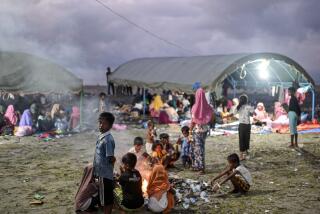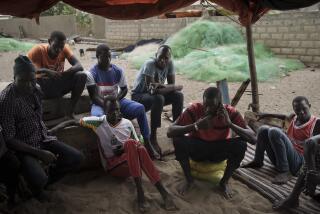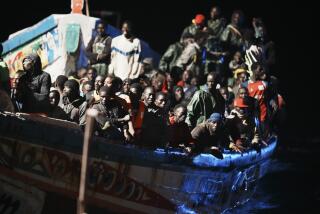Desperate Haitians Inundating Bahamian Shores
- Share via
NASSAU, Bahamas — Philogene Brutus prepared to return to his desolate life in Haiti last week bearing the wounds of his search for a better one.
His arms and legs were deeply scabbed from an eight-day trek through the scrub and rocks of a barren Bahamian island. He was weak from a diet of wild sea grapes and rainwater. Sullen and empty-eyed in an interview room of the Bahamian Immigration Department, he clearly was haunted by the four days he spent crammed into the cargo hold of a homemade wooden sloop, and the fierce, long days lost on land after the boat capsized off the Bahamas.
He had paid $500 for the privilege, the unemployed 29-year-old recalled during a pained, two-hour recounting of a failed odyssey from poverty that left at least two Haitians dead.
Bahamian authorities have deported more than 100 Haitian survivors of last month’s shipwreck, the latest tragedy in an exodus that is spreading Haiti’s trauma to the idyllic Bahamas and beyond. And police continued to search the archipelago’s southernmost island last week for others--alive or dead.
Driven by their country’s enduring economic stagnation, political paralysis and crime, Haitians headed for the United States are landing on Bahamian shores by the thousands this year.
Some are dying. Others are being sent home, at no small cost to the Bahamian government. Thousands more are landing undetected, living and working illegally in menial jobs on these tourist-dependent islands to raise the fare to go on to Florida. No one even knows how many Haitians are here. The Bahamian government estimates 30,000; the United Nations puts the number closer to 60,000.
What is clear is that their numbers are rising.
Official figures show that Bahamian authorities deported 3,574 Haitians in the first six months of this year, compared with 4,879 in all of last year. The cost: $1.1 million. And the Nassau government spent $1 million more to build a new detention facility to house the migrants until they can be sent home.
The reason is principally geographic: The vast Bahamian chain, which includes about 700 islands and covers a sea mass roughly the length of California, lies between Haiti and Miami.
“It’s not a Bahamian problem. It’s a Caribbean problem, but the Bahamas bears the brunt of it,” said William Nottage, the Bahamas’ chief of immigration enforcement. “It’s very serious, and it’s growing.”
So is popular resentment. On radio call-in shows and on the streets, Bahamians worry about the migrant influx and the loss of culture in this relatively prosperous former British colony where the titles “Dame” and “Sir” remain common parlance.
As a result, Bahamian Prime Minister Hubert A. Ingraham has been at the forefront of efforts by Caribbean nations and the Organization of American States to help Haitian President Jean-Bertrand Aristide break a domestic political stalemate that has frozen hundreds of millions of dollars in international development aid to Haiti.
Aristide’s government blames the impasse on intransigence by the nation’s small yet vocal political opposition. Opposition leaders say the former Roman Catholic priest, who was elected to a second term in November, has become a self-styled dictator. And caught in the middle are 8 million Haitians, whose average annual incomes of $250 make them the poorest of the Western Hemisphere’s poor.
Haitians ‘Have Lost Hope,’ Diplomat Says
“The masses still believe in President Aristide. Unfortunately, the president has inherited a crisis which is getting worse,” said Joseph Etienne, who has served as Haiti’s top diplomat in Nassau for the past 10 years. “There was a time when they thought things would change. But people have lost hope. Now, it’s a matter of despair.”
But Etienne also blames the phenomenon on sophisticated and ruthless migrant-smuggling rings. The smugglers, he said, charge as much as $5,000 a head, stow their human cargo in unsafe vessels and pocket the money regardless whether the customers reach their destination.
Brutus, the shipwreck survivor, told of saving up for the fare for months with money sent to him by relatives abroad.
In attempting to reconstruct his voyage, Brutus gave an account that differed from similarly conflicting accounts of other survivors--and from the facts, as recorded by the Bahamian and U.S. authorities who rescued them. That’s common, Bahamian investigators say.
“They’re all going back to Haiti,” said one Bahamian immigration investigator. “They have to protect themselves [from retribution]. And they always want us to think they were going somewhere other than here.”
Brutus insisted that their destination was Providenciales, a town in the British-ruled Turks and Caicos Islands chain that neighbors the Bahamian island of Great Inagua. There, he asserted, he and many of the other passengers had relatives who could help legalize their migrant status, although Bahamian investigators said they were convinced that the group meant to land illegally in the job-rich northern Bahamas.
Boat Carrying Migrants Had No Map, Compass
They boarded the boat in the northern port city of Cap Haitien about 8 p.m., Brutus said, adding that he had no clue what the date was. The 30-foot boat had no engine, just a sail, and the captain had neither map nor compass. Brutus estimated the cargo at about 125 people--all jammed below deck with just enough food and water for an expected three-day voyage.
A day into the sail, though, Brutus said, they hit rough seas that disoriented the captain. They sailed aimlessly for three more days, he said, until the captain spotted the shores of what turned out to be Great Inagua.
As the sloop headed for land, it struck a reef and sank.
“Water was rushing into the hold, and everyone was desperate. We climbed all over each other trying to get on deck and jump into the sea,” Brutus said. “No one died. Not then.”
On land, the group wasn’t as lucky.
Great Inagua is a flat, 20-by-40-mile mass of salt beds, razor-edged rock, scrub, mosquitoes and wild boar. About 1,000 Bahamians live there, but all of them are clustered in and around Matthew Town on the island’s southwestern tip. The sloop sank off the island’s North East Point.
Once they swam the 100 yards to shore, the Haitians split up into groups and set off in search of civilization. Nottage, the Bahamian immigration enforcement chief, served on Great Inagua several years ago, and he reckons that most of the group walked in circles for days.
“It’s a huge and disorienting landmass with a large lake in the middle,” he said. “If you don’t know where you’re going, you’re just walking around and around until you drop.”
At least one Haitian did. Brutus and other passengers said three died on the island, but Bahamian authorities found just one body after they discovered the group July 24; another died of his injuries in a Matthew Town clinic.
“A group of seven of them just walked right into Matthew Town,” Nottage said. “Their feet were badly cut and bleeding. They were seriously dehydrated and very hungry.”
Bahamian authorities quickly mobilized a search, rescue and arrest operation, calling in a U.S. Coast Guard helicopter based on the island. The helicopter came back with 62 people the following day. Eight more were found the next day on the uninhabited island of Little Inagua. And, in the ensuing days, the rest turned up, with Brutus among the last to enter Matthew Town.
One Survivor to Be Tried on Drug Charge
Bahamian authorities chartered a plane to fly 100 of them home late last month. Brutus and another survivor were sent home this month. Only one has remained: a passenger who was arrested after he allegedly turned up holding 2.2 pounds of cocaine.
“Usually they bring only a few changes of clothes and enough to get started wherever they land,” Nottage said. “A kilo of cocaine can get you a pretty good start. But in this case, he’ll be tried and then deported.”
On balance, Brutus said as he rubbed his scabs, he regrets having boarded the sloop, saying he did so only to support his wife and 5-year-old son. He attributed his survival to his belief in God and insisted that he will start saving family remittances again when he gets home--but for a passport, a visa and a plane ticket this time.
Asked what else he plans to do when he arrives at his family’s home on Rue 3 in Cap Haitien, Brutus shook his head and said: “Nothing. There’s nothing there to do.”
More to Read
Sign up for Essential California
The most important California stories and recommendations in your inbox every morning.
You may occasionally receive promotional content from the Los Angeles Times.










